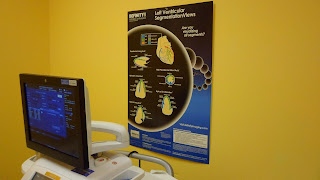5.1 Aurora
St Luke’s Medical Center:
Protocol For Tranthoracic Echocardiogram (TTE)
Parasternal Long Axis View
- Parasternal long axis view without colour, clip or acquire image
- Zoom Parasternal long axis of Aortic Valve and Mitral Valve
- Parasternal long axis with colour through Aortic Valve and Mitral Valve
- Interventricular septum with colour (TRO Ventricular Septal Defect)
- If Aortic Stenosis is suspected, zoom Left Ventricular Outflow Tract and measure diameter (may skip if no aortic stenosis is suspected)
- M-Mode of Aortic Valve and Left Atrium, freeze frame
- M-Mode of Mitral Valve and Left Atrium, freeze frame
- M-Mode of Left Ventricle and Right Ventricle, freeze frame
- M-Mode measurement are optional
- Additional images or still frames if necessary
Right Ventricular Outflow View
- Right Ventricular Inflow and Tricuspid Valve without color (include Right Ventricular anterior wall motion if possible
- Right Ventricular Inflow and Tricuspid Valve with color
- Continuous wave Doppler of Tricuspid Regurgitant jet, measure peak velocity for Right Ventricular systolic pressure (freeze image)
- Additional images or still frames if necessary
Parasternal Short Axis View
- Short axis view of Aortic Valve and Left Atrium without color, zoom if necessary
- Short axis view of Aortic Valve with color if Aortic Insufficiency is present in Parasternal long axis view
- Short axis view of Pulmonic Valve and Pulmonary Artery without color (demonstrate bifurcation if possible)
- Short axis of Pulmonic Valve and Pulmonary Artery with color
- Continuous wave or Pulse wave Doppler of Pulmonic Valve and Pulmonic Insufficiency jet
- Continuous wave Doppler of Pulmonic Valve, if Pulmonic Stenosis is present (measure Pulmonic Valve velocity and mean gradient from Pulmonic Stenosis waveform)
- Tricuspid Valve without color
- Tricuspid Valve with color
- Continuous wave Doppler of Tricuspid Regugitation jet, measure peak velocity for Right Ventricular systolic pressure (optional if measured in RV inflow view)
- Short axis view of Mitral valve without color
- Short axis view of Mitral valve with color (if mitral regurgitation is present in Parasternal long axis view
- Short axis view of Left Ventricle at mid papillary muscle level without color
- Short axis view of Left Ventricular apex (if obtainable in Parasternal short axis)
Measurement
- Parasternal long axis view with 2D measurements in end diastole while image is freeze (measure Right Ventricular internal dimension in diastole, interventricular septal thickness, Left Ventricular internal dimension in diastole, Posterior wall thickness,aortic root, also measure Ascending Aorta if dilated
- Parasternal long axis view with 2D measurements in systole while image is freeze (measure Left Ventricular internal dimension in systole and Left Atrial dimension in systole).
Apical 4 Chamber
- 4 Chamber view without color
- Zoom, Left Ventricle, if segmental abnormalities are noted optimizing endocardium. (If wall motion abnormalities are noted, trace Left Ventricle in diastole and systole using Biplane method to determine Left Ventricular ejection fraction).
- 4 Chamber view with color through Mitral Valve
- Continuous Wave and Pulse Wave Doppler through Mitral Valve with measurement of E/A ratio (if patient is in normal sinus rhythm, optional and can be done in apical long axis view)
- 4 chamber view with color of Tricuspid Valve
- Continuous wave Doppler of Tricuspid Regurgitation jet, measure peak velocity for Right Ventricular systolic pressure
- Additional images or still frames if necessary
Apical 5 Chamber
- 5 Chamber view without color
- 5 Chamber view with color through Aortic Valve
- Continuous wave Doppler demonstrating Aortic Insufficiency envelope
- Continuous wave Doppler demonstrating Aortic Valve and Left Ventricular outflow tract with measurement (if Aortic stenosis or systolic anterior motion of the anterior leaflet of the Mitral Valve is noted)
- Pulse wave Doppler of Left Ventricular outflow tract if Aortic Stenosis is present (measure for Aortic Stenosis)
- Pulse wave Doppler in all areas of Left Ventricular outflow tract if hypertrophic cardiomyopathy is noted
- Additional images or still frames if necessary
Apical 2 Chamber
- 2 Chamber view without color
- Zoom, Left Ventricle, if segmental abnormalities are noted optimizing endocardium. (If wall motion abnormalities are noted, trace Left Ventricle in diastole and systole using Biplane method to determine Left Ventricular ejection fraction).
- 2 Chamber view with color through Mitral Valve
- Additional images or still frames if necessary
Apical Long Axis
- Long axis view without color
- Long axis view with color through Aortic Valve and Mitral Valve
- Continuous wave or Pulse wave Doppler through Mitral Valve with measurement of E/A ratio (patient in normal sinus rhythm, optional if done in apical 4 chamber)
- Continuous wave or Pulse wave Doppler through Aortic Valve with or without measurements (as indicated by pathology)
- Additional images or still frames if necessary
Subcostal View
- 4 Chamber view without colour
- 4 Chamber view with color (Interatrial septum with color, to rule out atrial septal defect)
- Short axis view without color, base of heart (if indicated by pathology)
- Inferior vena cava or Hepatic veins without color
- Inferior vena cava or Hepatic veins with color
- Pulmonary artery with bifurcation from subcostal if not attained in Short axis view
- Additional images or still frames if necessary
Suprasternal Notch
- Aortic arch without color
- Aortic arch with color
- Continuous wave Doppler if Aortic Stenosis is present, measure for gradient and Aortic Valve area if possible
- Continuous wave Doppler if severe Aortic Insufficiency is present
- Continuous wave Doppler if coarctation is present, measure gradient if possible
- Additional images or still frames if necessary
Right Parasternal
- When indicated for Aortic Stenosis with the Pedoff probe
- Continuous wave Doppler of peak Aortic Valve flow, measure gradients for Aortic Valve area
Contrast
Echocardiography



No comments:
Post a Comment